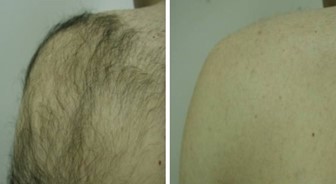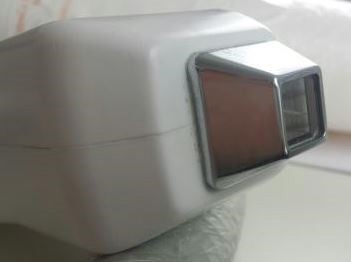A discussion on Hair Growth and Diode Laser Hair Removal - Part 2
Laser hair removal.
Laser hair removal is the process of removing unwanted hair by means of exposure to pulses of laser light that destroy the hair follicle.
It has been available commercially since in the mid-1990’s but had been performed experimentally for about twenty years prior to this.
The efficacy of laser hair removal is now fully accepted in the dermatology community, and laser hair removal is widely performed, throughout the UK and around the world. Many reviews of laser hair removal methods, safety, and efficacy have been published in the dermatology literature and laser hair removal is now generally considered the “Gold Standard” in hair removal & hair reduction treatments.

Mechanism of Laser Action.
The primary principle behind laser hair removal is “selective photothermolysis” (SPTL), the matching of a specific wavelength and pulse duration of light, for a duration equal or less that the thermal relaxation time of a targeted tissue, to obtain optimal destructive effect on it with minimal effect on surrounding tissue.
The thermal relaxation time of the follicular structure is dependent on its diameter and is in the order of tens of milliseconds. Consequently, the elits epil808 laser has a range of pulse widths from 5 – 100 ms to selectively damage different size follicles.
As light is absorbed by dark objects, so laser energy can be absorbed by dark material in the skin, but with much more speed and intensity. This dark target matter, or chromophore, can be naturally-occurring or artificially introduced. Lasers can thus cause localized damage by selectively heating dark target matter, melanin, in the hair follicle, while not heating the rest of the skin.
Melanin is the primary chromophore for hair removal lasers. Melanin occurs naturally in the skin, and gives skin and hair their colour. There are two types of melanin in hair. Eumelanin gives hair brown or black colour, while pheomelanin gives hair blonde or red colour. Because of the selective absorption of photons of laser light, only black or brown hair can be removed. Laser works best with dark coarse hair. Light skin and dark hair are an ideal combination, being most effective and producing the best results.
Hair removal lasers have been approved for "permanent hair reduction" in the United States by the Food and Drug Administration (FDA) since 1997. Under the FDA's definition, "permanent" hair reduction is the long-term, stable reduction in the number of hairs regrowing after a treatment regime. Indeed, many patients experience complete regrowth of hair on their treated areas in the years following their last treatment. This means that although laser treatments with these devices will permanently reduce the total number of body hairs, they will not result in a permanent removal of all hair.
Laser hair removal has become popular because of its speed and efficacy, although some of the efficacy is dependent upon the skill and experience of the laser operator, and the choice and availability of different laser technologies used for the procedure. Some will need touch-up treatments, especially on large areas, after the initial set of 3-8 treatments.
Factors affecting the efficacy of laser hair removal
Over the years, laser energy of a variety of wavelengths have been used for hair removal, from visible light to near-infrared radiation. These lasers are characterized by their wavelength, measured in nanometres (nm):
The Pulsed Diode Array of the elits epil808 operates at 808nm in the near infrared portion of the spectrum.
Pulse width (or duration) is one of the most important factors. The length of the heating pulse has a direct correlation to the damage achieved in the follicle. When attempting to destroy hair follicles, the main target is the germ cells which reside on the surface of the hair shaft. Light energy is absorbed by the melanin within the hair and heat is generated. The heat then conducts out towards the germ cells. As long as a sufficient temperature is maintained for the required time then these cells will be successfully destroyed. This is absolutely critical - attaining the require temperature is not sufficient unless it is kept at that temperature for the corresponding time. To achieve these conditions, the laser system must be able to generate the required power output.
Spot size, or the width of the laser beam, directly affects the depth of penetration of the light energy due to scattering effects in the dermal layer. Larger beam diameters result in deeper deposition of energy and hence can induce higher temperatures in deeper follicles.
Fluence or energy density is another important consideration. Fluence is measured in joules per square centimetre (J/cm²). It's important to get treated at high enough settings to heat up the follicles enough to disable them from producing hair.
Epidermal cooling has been determined to allow higher fluence and reduced pain and side effects, especially in darker skin. Three types of cooling have been developed, but Contact cooling: through a window cooled by circulating water is by far the most efficient method of keeping the epidermis protected since it provides a constant heat sink at the skin surface.
Example of cooling tip - from the Elits epil808 Diode laser

In short, the important output parameter when treating hair (and other skin conditions) is power density - this is a combination of energy, spot diameter and pulse duration. These three parameters determine what actually happens when the light energy is absorbed by the melanin or any other tissue chromophore, with the amount of tissue damaged being determined by the temperature/time combination.
Number of sessions required
As has been described above, hair grows in several phases (anagen, telogen, catagen) and a laser can only affect the currently active growing hair follicles (early anagen). Hence, several sessions are needed to kill hair in all phases of growth.
Multiple treatments depending on the type of hair and skin colour have been shown to provide long-term reduction of hair. Most patients need a minimum of six or seven treatments. Clinicians generally recommend waiting from three to eight weeks between sessions, depending on the area being treated. The number of sessions depends on various parameters, including the area of the body being treated, skin colour, coarseness of hair, reason for any hirsutism, and gender. Coarse dark hair on light skin is easiest to treat. Certain areas (notably men's faces) may require considerably more treatments to achieve desired results.
Laser does not work well on light-coloured hair, red hair, grey hair, white hair, as well as fine hair of any colour.
Typically, the shedding of the treated hairs takes about two to three weeks. These hairs should be allowed to fall out on their own and should not be manipulated by the patient, chiefly to reduce the risk of infections.
Side effects and risks
Some normal side-effects may occur after laser hair removal treatments, including itching, pink skin, redness, and swelling around the treatment area or swelling of the follicles (follicular oedema). These side-effects rarely last more than two or three days. The two most common serious side-effects are acne and skin discolouration.
Some level of pain may also be expected during treatments. Use of strong numbing creams over large skin areas being treated at one time must be avoided, as this has seriously harmed, and even killed, patients.
Unwanted side-effects such as hypo- or hyper-pigmentation or, in extreme cases, burning of the skin, requires an adjustment in laser settings. Risks include the chance of burning the skin or discolouration of the skin - hypo-pigmentation (white spots), flare of acne, swelling around the hair follicle (considered a normal reaction), scab formation, purpura, and infection. These risks can be reduced by treatment with an appropriate laser type used at appropriate settings for the individual's skin type and treatment area.

